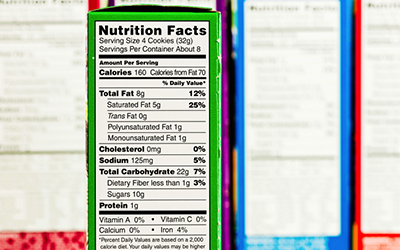



Reading packaged food labels can sometimes feel like deciphering a foreign language. In a recent Student Health 101 survey, nearly 68 percent of respondents said they look at the information provided, but only about 20 percent feel they understand all of it. Christina T., a third-year student at Nipissing University in North Bay, Ontario, says, “Nutrition labels can be very confusing if you don’t know what the numbers and percentages are referencing. [This affects my ability to] make informed decisions when trying to shop for healthy food.”
Nick talks about how to analyze nutrition labels. (MP4, 04:01)
The Canadian Food Inspection Agency (CFIA) requires that most packaged foods use standard labels.
These must list, among other things, the food’s ingredients and basic nutritional information. This includes:
Percent Daily Values
All % DVs are based on optimal intake levels for energy (calories), nutrients, and other food components based on gender and age. Nutrition labels are based on a 2,000 calorie diet, so if you consume more or fewer, the information won’t be quite accurate for you.
The most commonly used guide is Recommended Dietary Allowances (RDAs), a set of standards scientists in Canada and the U.S. have been working together to develop since 1995. RDAs are sufficient to meet the needs of 97-98 percent of healthy people. More recently, additional standards have been developed, such as Tolerable Upper Intake (UI) levels: maximum daily nutrient intake levels unlikely to pose a risk of adverse health effects to almost all healthy people.

Serving Size/Servings per Container
The facts listed on a package are based on one serving of the food. At the top of the Nutrition Facts chart you’ll find a recommended serving size noting how many grams of the item (or individual pieces) make up what a person is expected to eat at one time.
This is tricky, especially when it comes to calorie-dense foods. The manufacturer may list a very small serving size, making the quantity of calories, fat, and other contents appear to be less than you might realistically consume. It’s not uncommon for small packages (like those in a vending machine) and bottled beverages to contain two or more servings. For example, a “snack-size” package of potato chips might have two servings, while most people would eat the whole bag. This can be true of “healthy snacks,” like granola bars, too. So before diving into the carton, make sure you understand the serving size.
Calories
Almost 70 percent of the respondents to the Student Health 101 survey reported that they pay attention to calorie listings, which indicate how much energy you will get from eating a particular food. Although items that are high in calories are sometimes considered an indulgence, the total per serving isn’t a full indicator of the food’s healthfulness. Laura B., a third-year student and multi-sport coach at the University of Guelph in Toronto, Ontario, says, “A lot of people overemphasize calories. It’s important to take note of nutrient density as well.”
Fat
When it comes to fat, quality trumps quantity. There are different types of fat, and the ratio of them in your diet is more important than the total amount, although it is recommended that 20-35 percent of your total calories come from fat. (This is equal to about 50-65 grams daily.)
The CFIA requires that companies list every ingredient in their products. The ingredients at the beginning of a list are found in higher concentrations, while those at the very end of the list may appear in trace amounts. (You may have noticed the phrase “Contains less than 2 percent of the following” on many labels.)
Manufacturers don’t want to give away their secret recipes, so you’ll often see things like “spices” or “natural flavours” listed. You may also see a few possible options, such as two or three types of oil.
If you have food allergies or other dietary restrictions, pay close attention. Many products now call out substances that are commonly a problem, including eggs, fish and seafood, milk and lactose, peanuts and tree nuts, soy, wheat, and gluten. Some companies also indicate if a product was made on shared equipment.
Mystery Ingredients
Curtis A., a fourth-year student at George Brown College in Toronto, says, “The fewer ingredients a food has listed, the better.” But have you ever found yourself in the grocery aisle asking, “What is that ingredient?”
The Joint Food and Agriculture Organization of the United Nations/World Health Organization Expert Committee on Food Additives provides guidelines to ensure consumer safety, and the Government of Canada’s Food and Drug Regulations mandate rigorous pre-market evaluations for all additives to ensure they “Do not pose a hazard to the health of the consumer.”

Companies that manufacture prepared foods often use words like “light,” “lean,” or “low” to advertise their products. But many low-fat and fat-free products contain hidden salt, sugars, and other additives to compensate for the flavour lost through fat removal. “Low-fat frozen dinners seem like a healthy choice based on packaging,” says Kierra P., a first-year student at McGill University in Montreal, Quebec. “But when you look [at the nutrition labels], they are often packed full of sodium!”
Also be wary of products claiming to be “calorie-free,” which, according to CFIA guidelines, have fewer than five calories per serving. Diet products tend to be less satisfying, so you may eat more than you would of a more filling option, and you’d be surprised how quickly five calories at a time can add up! Plus, calorie-free foods might contain plenty of other things your body doesn’t need.
If you understand and use the nutritional information on labels, you can make the most of your time at the grocery store.
Chris suggests looking for whole-food ingredients. (MP4, 04:45)
HEIDI PREIBE is a fourth-year student studying Psychology at the University of Guelph.
Saturated fats are found primarily in animal products-such as red meat, poultry skin, and whole dairy products-but are also in some plant oils, such as coconut and palm.
Diets high in saturated fat have been shown to increase a person’s cholesterol levels and can be associated with a higher risk of developing health problems, such as heart disease.
As a result, it is recommended that most people consume no more than 10 percent of their total daily calories from saturated fat. A good guide is to choose foods with less than or equal to 3.5 grams of saturated fat per serving.
Unsaturated (monounsaturated and polyunsaturated) fats are considered important elements of a healthy diet. They are required for the body to maintain normal function, and can only be obtained naturally, from food.
These fats are not always specifically listed on ingredient labels, but can be calculated by subtracting the amount of saturated and trans fat indicated from the total fat.
Good sources of unsaturated fats include fish, nuts, seeds, olive oil, avocados, and peanut butter.
Trans fats are unsaturated fats that have been modified by food manufacturers to enhance the flavor, appearance, and shelf life of foods. Unfortunately, after they are modified, they behave in the body like saturated fats-and have been shown to clog arteries and increase a person’s risk for cardiovascular disease.
Trans fats can be sneaky to find on food labels. Look for words like “hydrogenated” or “partially hydrogenated” oil in ingredient lists. Health Canada recommends choosing foods that contain little or no trans-fats.
There is a common misperception that cholesterol is bad. In fact, your body needs it to run smoothly, and recent longitudinal studies with huge sample sizes have found that higher cholesterol levels in the blood are not directly related to higher dietary intake of cholesterol. For many people, genetic factors impact the production of cholesterol by their own bodies.
Nonetheless, The Heart and Stroke Foundation of Ontario recommends that healthy adults consume no more than 300 mg of cholesterol daily.
More information about “good” and “bad” cholesterol.
Sodium is an electrolyte that works in conjunction with potassium to regulate bodily functions. But in excess, sodium can lead to health problems, such as high blood pressure.
The maximum daily sodium intake for healthy adults (aged 14 and over) is 2,300 mg a day. Kierra P., a first-year student at McGill University in Montreal, Quebec, says, “Some microwavable meals or fast food menu items contain your entire daily allowance of sodium! It’s important to monitor what you’re buying, especially when it comes to fast food.” In order to stay within the guidelines, select items with 240 mg or fewer of sodium per serving.
Here are some phrases commonly used on labels:
Sodium Free: The product contains less than 5 mg of sodium, and no sodium chloride, a chemically derived form of salt.
Lightly Salted: The food contains at least 50 percent less sodium than what’s added to a similar product.
Low sodium: The product contains 140 mg or fewer of sodium.
Reduced sodium: The product contains at least 25 percent less sodium than the manufacturer’s original recipe.
Listing potassium on nutrition labels is optional, but it’s recommended that healthy adults get about 4,700 mg daily. This essential nutrient is found in milk, meat, fresh fruits and vegetables, beans, and nuts. When listed, choose items with at least 300 mg of potassium per serving.
Monosodium glutamate (MSG)
High fructose corn syrup
BHT
Red No. 40
Sodium nitrate/nitrites
Lechithin
Sodium benzoate
Carrageenan
Aspartame
Saccharin
Sucralose
According to Dietitians of Canada, consumers should practice moderation in their consumption of the above sweeteners.
According to Health Canada, the health claims commonly found on food packaging have the following meanings:
Fat free: The product contains less than .5 g of fat per serving.
Trans-fatty Acids Free: The product contains less than 0.2 g of trans fatty acids per serving. However, if the item contains ingredients such as “hydrogenated oil” or “partially hydrogenated oil,” it has traces of trans fats which can add up when consumed regularly.
Low fat: The product contains 3 g of fat or fewer per serving.
Reduced fat: The product has at least 25 percent less fat than the manufacturer’s original recipe.
Lean: The product contains less than 10 percent fat.
Extra lean: The product contains 7.5 percent fat or less.
Light: The product contains at least 25 percent fewer calories or 1/4 less fat than the manufacturer’s original recipe.
A note about protein: According to Health Canada, most Canadians get enough protein on a daily basis. Therefore, % DV of protein is not listed on nutrition labels.
Use the following tips to select foods with a lot of nutritional bang for your buck:


